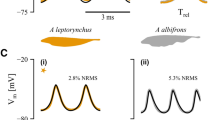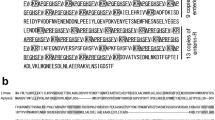Abstract
The wave-type African weakly electric fish Gymnarchus niloticus produces electric organ discharges (EODs) from an electric organ in the tail that is driven by a pacemaker complex in the medulla, which consists of a pacemaker nucleus, two lateral relay nuclei and a medial relay nucleus. The prepacemaker nucleus (PPn) in the area of the dorsal posterior nucleus of the thalamus projects exclusively to the pacemaker nucleus and is responsible for EOD interruption behavior. The goal of the present study is to test the existence of inhibition of the pacemaker nucleus by the PPn. Immunohistochemical results showed clear anti-GABA immunoreactive labeling of fibers and terminals in the pacemaker nucleus, but no apparent anti-glycine immunoreactivity anywhere in the pacemaker complex. GABA injection into the pacemaker nucleus could induce EOD interruptions that are comparable to the interruptions induced by glutamate injection into the PPn. Application of the GABAA receptor blocker bicuculline methiodide reversibly eliminated the effects of stimulation of the PPn. Thus the EOD interruption behavior in Gymnarchus is mediated through GABAergic inhibition of the pacemaker nucleus by the PPn.











Similar content being viewed by others
References
Bullock TH, Behrend K, Heiligenberg W (1975) Comparison of the jamming avoidance responses in Gymnotoid and Gymnarchid electric fish: a case of convergent evolution of behavior and its sensory basis. J Comp Physiol A 103:97–121
Bullock TH, Bodznick DA, Northcutt RG (1983) The phylogenetic distribution of electroreception: evidence for convergent evolution of a primitive vertebrate sense modality. Brain Res 287:25–46
Carlson BA (2002) Neuroanatomy of the mormyrid electromotor control system. J Comp Neurol 454:440–455
Carlson BA (2003) Single-unit activity patterns in nuclei that control the electromotor command nucleus during spontaneous electric signal production in the mormyrid Brienomyrus brachyistius. J Neurosci 23:10128–10136
Carlson BA, Hopkins CD (2004) Central control of electric signaling behavior in the mormyrid Brienomyrus brachyistius: segregation of behavior-specific inputs and the role of modifiable recurrent inhibition. J Exp Biol 207:1073–1084
Dumont JPC, Robertson RM (1986) Neuronal circuits: an evolutionary perspective. Science 233:849–852
Dye J, Heiligenberg W, Keller CH, Kawasaki M (1989) Different classes of glutamate receptors mediate distinct behaviors in a single brainstem nucleus. Proc Natl Acad Sci 86:8993–8997
Feldman JL, Smith JC (1989) Cellular mechanisms underlying modulation of breathing pattern in mammals. Ann N Y Acad Sci 563:114–130
Finger TE, Bell CC, Carr CE (1986) Comparisons among electroreceptive teleosts: why are electrosensory systems so similar? In: Bullock TH, Heiligenberg W (eds) Electroreception. Wiley, New York, pp 465–481
Fu J, Lorden JF (1996) An easily constructed carbon fiber recording and microiontophoresis assembly. J Neurosci Methods 68:247–251
Grant K, Bell CC, Clausse S, Ravaille M (1986) Morphology and physiology of the brainstem nuclei controlling the electric organ discharge in mormyrid fish. J Comp Neurol 245:514–530
Grant K, von der Emde G, Sena LG, Mohr C (1999) Neural command of electromotor output in mormyrids. J Exp Biol 202:1399–1407
Grillner S, Deliagina T, Ekeberg O, el Manira A, Hill RH, Lansner A, Orlovsky GN, Wallen P (1995) Neural networks that co-ordinate locomotion and body orientation in lamprey. Trends Neurosci 18:270–279
Grillner S, Georgopoulos AP (1996) Neural control. Curr Opin Neurobiol 6:741–743
Grillner S, Matsushima T (1991) The neural network underlying locomotion in lamprey–synaptic and cellular mechanisms. Neuron 7:1–15
Harris-Warrick RM, Marder E (1991) Modulation of neural networks for behavior. Annu Rev Neurosci 14:39–57
Hille B (2001) Ion Channels of excitable membranes. Sinauer Associates, Sunderland
Hopkins CD (1974) Electric communication in fish. Am Sci 62:426–437
Hopkins CD (1986) Behavior of mormyridae. In: Bullock TH, Heiligenberg W (eds) Electroreception. Wiley, New York, pp 527–576
Katz PS (1995) Intrinsic and extrinsic neuromodulation of motor circuits. Curr Opin Neurobiol 5:799–808
Kawasaki M (1993) Independently evolved jamming avoidance responses employ identical computational algorithms: a behavioral study of the African electric fish, Gymnarchus niloticus. J Comp Physiol A 173:9–22
Kawasaki M (1994) The African wave-type electric fish, Gymnarchus niloticus, lacks corollary discharge mechanisms for electrosensory gating. J Comp Physiol A 174:133–144
Kawasaki M (2001) Cutaneous electrical oscillation in a weakly electric fish, Gymnarchus niloticus. J Comp Physiol A 187:597–604
Kawasaki M, Heiligenberg W (1989) Distinct mechanisms of modulation in a neuronal oscillator generate different social signals in the electric fish Hypopomus. J Comp Physiol A 165:731–741
Kawasaki M, Heiligenberg W (1990) Different classes of glutamate receptors and GABA mediate distinct modulations in the firing pattern of a neuronal oscillator, the medullary pacemaker of gymnotiform electric fish. J Neurosci 10:3896–3904
Keller CH (1988) Stimulus discrimination in the diencephalon of Eigenmannia: the emergence and sharpening of a sensory filter. J Comp Physiol A 162:747–757
Keller CH, Kawasaki M, Heiligenberg W (1991) The control of pacemaker modulations for social communication in the weakly electric fish Sternopygus. J Comp Physiol A 169:441–450
Lauder GV, Liem KF (1983) Patterns of diversity and evolution in ray-finned fishes. In: Northcutt RG, Davis RE (eds) Fish neurobiology. 1 University of Michigan Press, Ann Arbor, pp 1–24
Marder E, Calabrese RL (1996) Principles of rhythmic motor pattern generation. Physiol Rev 76:687–717
Metzner W (1999) Neural circuitry for communication and jamming avoidance in gymnotiform electric fish. J Exp Biol 202:1365–1375
Pearson KG (1993) Common principles of motor control in vertebrates and invertebrates. Annu Rev Neurosci 16:265–297
Ramirez JM, Richter DW (1996) The neuronal mechanisms of respiratory rhythm generation. Curr Opin Neurobiol 6:817–825
Sullivan JP, Lavoue S, Hopkins CD (2000) Molecular systematics of the African electric fishes (Mormyroidea: teleostei) and a model for the evolution of their electric organs. J Exp Biol 203:665–683
Szabo T (1959) Organisation particulière de la comande nerveuse centrale de la décharge chez un Poisson èlectrique, Gymnarchus niloticus. C R Acad Sci Paris 248:2488–2489
Szabo T (1962) The activity of cutaneous organs in Gymnarchus niloticus. Life Sci 7:285–286
Tegner J, Grillner S (1999) Interactive effects of the GABAergic modulation of calcium channels and calcium-dependent potassium channels in lamprey. J Neurophysiol 81:1318–1329
von der Emde G, Sena LG, Niso R, Grant K (2000) The midbrain precommand nucleus of the mormyrid electromotor network. J Neurosci 20:5483–5495
Zhang Y, Kawasaki M (2006) Interruption of pacemaker signals by a diencephalic nucleus in the African electric fish, Gymnarchus niloticus. J Comp Physiol A 192:509–521
Acknowledgments
This work was sponsored by grants to M.K. from the National Science Foundation (IBN-0235533). We thank Drs. Bruce Carlson, Otto Friesen and Deforest Mellon for critical reading of the manuscript. All experimental procedures were approved by the University of Virginia Animal Care and Use Committee.
Author information
Authors and Affiliations
Corresponding author
Rights and permissions
About this article
Cite this article
Zhang, Y., Kawasaki, M. Interruption of pacemaker signals is mediated by GABAergic inhibition of the pacemaker nucleus in the African electric fish Gymnarchus niloticus . J Comp Physiol A 193, 665–675 (2007). https://doi.org/10.1007/s00359-007-0219-9
Received:
Revised:
Accepted:
Published:
Issue Date:
DOI: https://doi.org/10.1007/s00359-007-0219-9




